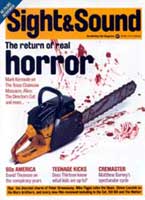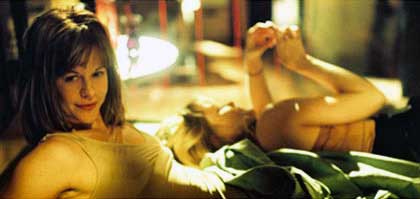
In the Cut
UK 2003

Reviewed by Leslie Felperin
Synopsis
Our synopses give away the plot in full, including surprise twists.
New York, the present. Frannie Avery is an English professor in her late 30s. Her half-sister Pauline lives nearby. Frannie goes for a drink at a bar with Cornelius, one of her students. On her way to the toilet she sees a man with a tattoo on his wrist receiving a blow job from a woman with blue fingernails. He notices her watching.
The next day Detective Malloy arrives at her apartment to ask if she saw anything the previous night that might help him find the killer of a woman whose body was found nearby. Frannie says she didn't. Malloy asks her out. Later Pauline gives her a charm bracelet as a birthday present.
While having a drink with Malloy she notices that he has the same tattoo as the man she saw in the bar. He says it is shared by members of a secret society. She learns that the woman she saw giving the blow job, Angela Sands, is the woman who was murdered. Later Frannie is attacked by a mugger. She calls Malloy to report the incident and when he comes over they have sex. Another woman's body is found. Frannie goes to the police station to look at mug shots. Malloy drives her to some woods where he shows her how to fire a gun.
Frannie discovers Pauline murdered, killed in the same manner as the other women. Grief-stricken, Frannie gets drunk in her apartment. Cornelius appears and makes an aggressive pass at her. She manages to fight him off. Malloy's partner Rodriguez is waiting outside, sent by Malloy to make sure she is all right. Malloy comes round later and Frannie handcuffs him to a pipe in a sex game. Finding a bit of the charm bracelet that she'd last seen at Pauline's in his jacket, she accuses Malloy of being the killer. She flees, still wearing his jacket. Rodriguez is waiting outside, and drives her to a lighthouse where he goes fishing. He turns out to be the killer. Rodriguez attacks Frannie but she shoots him with Malloy's gun. She walks back to her apartment and lies next to Malloy.
Review
In one of In the Cut's early scenes, English professor Frannie is teaching her students about Virginia Woolf's To the Lighthouse. They look bored, apathetic. One complains that all that happens in the book is "some old lady dies". Frannie asks how many women have to die to make it interesting. "At least three," comes the reply. A sensuous study of desire and masochism wrapped around a straight-up thriller (or perhaps vice-versa), In the Cut gives us three murdered women to keep these students interested while director Jane Campion attends to more troubling preoccupations. The result is one of her most provocative and complex films yet.
Largely faithful to Susanna Moore's compelling if slightly airless novel, In the Cut plays out like Bluebeard meets Sea of Love for the Sex and the City generation. Meg Ryan's Frannie and her half-sister Pauline are urban singletons, almost burnt out with bad relationships. Pauline, who lives above a friendly strip bar, has started specialising in safely unavailable married men while Frannie is practically celibate. Their distrust of men seems to have set in early due to a caddish father, seen courting Frannie's mother on a frozen lake in an oneiric flashback in which his skates score lines of blood into the ice and later amputate her mother's legs, surreal touches reminiscent of the fantasy sequences in Campion's The Portrait of a Lady.
Nearly every man here has the potential to transmute into a killer, from Frannie's student Cornelius with his John Wayne Gacy obsession, to her ex John Graham, an actor training to be a doctor and therefore familiar enough with anatomy to "disarticulate" (an apt word in a film preoccupied with language) women's limbs. Even Frannie's love interest, the elusive Detective Malloy who promises Frannie he can be "whoever [she] wants him to be", shows a disturbing side while joking with his partner Rodriguez (who himself tried to kill his wife). They josh that all men need from a woman is a "hole, tits and a heartbeat". Upping the misogynist ante, Malloy observes, "You don't even need the tits." Rodriguez goes one further: "Or the heartbeat."
What makes the film so provocative is that the more things point to Malloy being the killer, the more Frannie is drawn to him, turned on not just by his cunnilingus technique but also by his potentially lethal power. A woman of few, choice words, attracted to a man with a gift for spiel and animal magnetism, Frannie's relationship with Malloy recalls the sexual chemistry between Holly Hunter's mute, cerebral Ada and Harvey Keitel's gone-native Baines in The Piano. The sex scenes are especially pungent, scored with a kind of electronic keening on the soundtrack, and marked by a fetid grubbiness in the set design. The outstanding use of New York locations emphasises the sweltering atmosphere: scenes are observed as if through a heat haze of desire. The work of cinematographer Dion Beebe (Holy Smoke) is nothing less than extraordinary. Particularly innovative is the use of the travelling focal point that defocuses most of an image apart from one key detail in the frame, suggesting a sort of ecstatic subjectivity, a correlative of the "bitch vision" Cornelius boasts of mastering in his prose. The poetic look of the movie interlocks nicely with its literary sensibility. Frannie's eye is often drawn to the poems posted on the subway, which comment obliquely on the action.
As finely wrought as In the Cut is, one could argue that it fails as a genre exercise. Experienced thriller fans will guess the killer quicker than it takes to recite an Emily Dickinson poem. But once the mystery's burned away, what's left is a minutely etched study in mood and female psychology.
Credits
- Director
- Jane Campion
- Producers
- Laurie Parker
- Nicole Kidman
- Screenplay
- Jane Campion
- Susanna Moore
- Based on the novel by
- Susanna Moore
- Director of Photography
- Dion Beebe
- Editor
- Alexandre De Franceschi
- Production Designer
- David Brisbin
- Music/Music Arranger/ Producer
- Hilmar Örn Hilmarsson
